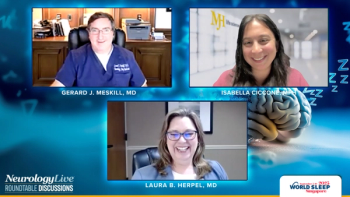
Natalizumab, Other High-Efficacy DMTs Offer Postpregnancy MS Relapse Protection
The data suggest that women considered at high relapse risk or with poor prognostic factors benefit peripregnancy from high-efficacy therapy continuation.
Natalizumab (Tysabri; Biogen) may offer an effective treatment option to minimize the risk of postpartum relapses in pregnant women with multiple sclerosis (MS) who pause treatment with disease-modifying therapy (DMT) during pregnancy, according to study findings published in Neurology. This is particularly true for those who are at low risk of progressive multifocal leukoencephalopathy, or PML.
DMT reinitiation with natalizumab protected against postpartum relapse (hazard ratio [HR], 0.11 [95% CI, 0.04-0.32]; P <.0001), while continuation of natalizumab use into pregnancy reduced the odds of relapse during pregnancy (odds ratio [OR], 0.76 per month [95% CI, 0.60-00.95]; P = .017).
Overall, reinitiation with high-efficacy DMT was independently protective against postpartum relapse and reduced the hazard of relapse by 88.9% (HR, 0.111 [95% CI, 0.0382-0.322]; P <.0001 compared to no treatment reinitiation). Additionally, those who breastfeed were also less likely to experience disease relapse (HR, 0.61 [95% CI, 0.41-0.91]; P = .016).
“Strategies of disease-modifying therapy use have to be balanced against potential fetal/neonatal complications… We found that 5.6% of pregnancies were followed by confirmed disability progression, predicted by higher relapse activity in pregnancy and postpartum,” Vilija G. Jokubaitis, PhD, senior research fellow, Department of Neuroscience, Monash University Data Futures Institute, and others in the MSBase Study Group wrote.
The investigation assessed pregnancy-related disease activity in a contemporary MS cohort of pregnancies conceived after December 31, 2010, in women with relapsing-remitting MS or clinically isolated syndrome. The total cohort included 1998 pregnancies from 1619 women. The preconception annualized relapse rate (ARR) was 0.29 (95% CI, 0.27-0.32)(FIGURE), which then fell in the third trimester to 0.19 (95% CI, 0.14-0.24), and increased in early postpartum to 0.59 (95% CI, 0.51-0.67).
WATCH NOW:
The DMTs included the study were categorized by relative efficacy into the following groups: low-efficacy (interferon beta; glatiramer acetate; teriflunomide [Aubagio; Sanofi Genzyme]; azathioprine), medium-efficacy (fingolimod [Gilenya; Novartis]; dimethyl fumarate; daclizumab), and high-efficacy (natalizumab; alemtuzumab [Lemtrada; Sanofi Genzyme]; rituximab [Rituxan; Genentech/Biogen]; ocrelizumab [Ocrevus; Genentech]; mitoxantrone, cyclophosphamide).
Those women who used fingolimod or natalizumab had an ARR before pregnancy of 0.37 (95% CI, 0.28-0.49) and 0.29 (95% CI, 0.22-0.37), respectively, which then increased during pregnancy. With the preconception use of dimethyl fumarate, intrapartum ARR decreased.
ARR spiked in early postpartum for every group but was highest in the natalizumab (0.881; 95% CI 0.645-1.18), fingolimod (0.947; 95% CI 0.656-1.32), and dimethyl fumarate (0.809; 95% CI 0.404-1.45) groups compared to the low-efficacy (0.474; 95% CI 0.385-0.578]) and no DMT (0.508; 95% CI 0.368-0.684) groups. ARR spiked after delivery across all DMT groups.
“For women of child-bearing age, our data inform DMT use that best controls disease activity during and after pregnancy as part of prepregnancy counseling. In women considered at high relapse risk or those with poor prognostic factors, high-efficacy therapy continuation in pregnancy attenuates the risk of relapse and disability accrual peripregnancy,” Jokubaitis and colleagues wrote. They added that alternative to natalizumab, the planned use of dimethyl fumarate, anti-CD20 therapy, or alemtuzumab can offer a long-lasting and effective method of disease control amid and postpregnancy, “which also allows avoidance of drug exposure during these times.”
Several limitations were identified, namely that data were contributed predominantly from subspecialist MS referral centers, which calls for caution in the interpretation within the context of other MS populations. Additionally, the investigators were not able to evaluate MRI measures of disease activity, nor was it recorded whether or not breastfeeding was mixed or exclusive. Jokubaitis and colleagues also noted that as there was a small group of women treated with dimethyl fumarate prepregnancy, further study will be needed to confirm their observations.
“Breastfeeding should be encouraged given its multiple benefits and potential protective effect against relapse. Because the safety of DMT is not yet well established in pregnancy and breastfeeding, clinicians should carefully discuss the benefits and risks with their patients. Well-designed prospective studies will help to confirm the effect of breastfeeding and the safety of DMT use in pregnancy and lactation,” Jokubaitis et al concluded.
REFERENCE
Yeh WZ, Widyastuti PA, Van der Walt, A, et al. Natalizumab, fingolimod, and dimethyl fumarate use and pregnancy-related relapse and disability in women with multiple sclerosis. Neurology. 2021;96:e2989-e3002. doi:10.1212/WNL.0000000000012084
Newsletter
Keep your finger on the pulse of neurology—subscribe to NeurologyLive for expert interviews, new data, and breakthrough treatment updates.




































